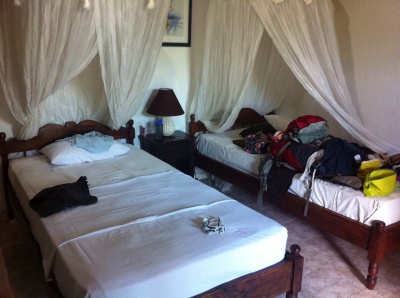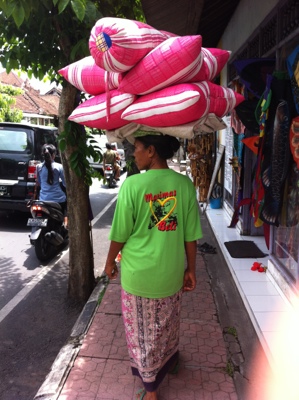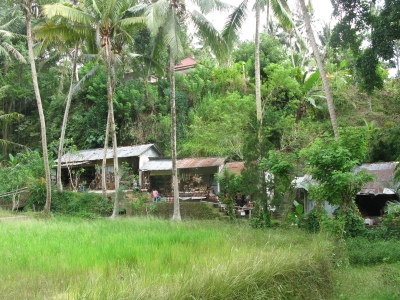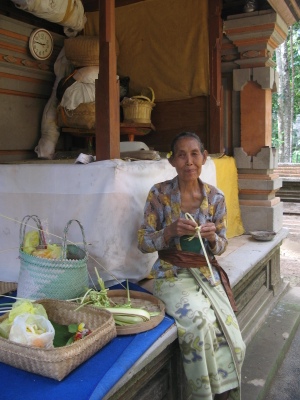Passing on Experience to Other Bali Travelers
I have arrived in Kuala Lumpur, but before I forget, I wanted to pass on some travel tips with specifics that can help another future traveler-to-Bali (if they find my blog with these tips!). In no particular order but categorized by my own Virgo mind:
TRANSPORT AROUND BALI
- Getting a taxi from the airport to Ubud should cost about 195.000 IDR. You can catch taxis waiting outside the airport at the departure waiting area. Make sure to set a price before hopping in the taxi. Move on to the next taxi if you the driver won't go down.
- A taxi from Sanur to the airport should cost anywhere between 80.000 to 100.000 IDR. I asked an honest guy the cost, and he said drivers shouldn't charge more than 80K. And when I talked to a driver, he first said 150.000, but I said 80.000, and he was surprised, and then we settled at 100.000. I talked to him the day before I was to go to the airport, and he came and picked me up at my guesthouse the next day, as arranged!
- In the guidebooks, they talk about “bemos” which are these vans that just drive around for way cheaper than taxis or shuttle buses. I never took one because I wasn't totally sure how it worked. I think if I had a travel partner, I might have tried…
- When getting from one town to another, there are usually many options, it's all about how much you want to spend and how “in style” you want to travel. This is what I have ascertained are the options:
- Bemo— mentioned above. The cheapest of the options– it's what the locals might use if they don't have their own motorbike. In busy areas, there are lots of guys yelling out, “bemo? bemo!”
- Shuttle bus— organized by private tour companies; and in Ubud, so I'm assuming probably in some other towns as well, also organized by the town's official Tourist Information Center. Lots of private tour companies also use the name “tourist information center,” so you have to be sure to find the official one. In Ubud, the UTI (as they call it. hee hee.) is right near the Ubud market. It looks all official with staff that work in official uniforms. Shuttle buses are a bus or van that goes to different towns, and the price is often based on a minimum of two people going. So if you're a single traveler, you're kind of stuck. Though at the UTI, I was able to book a bus to Amed, and didn't need a minimum of two people. It's way cheaper than a private driver. From Ubud to Amed, the shuttle bus through the UTI was 130.000 IDR. Do some “shopping around.” Tour companies often have boards listing their going rates for buses. When I was walking around Ubud, I saw that some companies did 150.000, 180.000, etc. to Amed.
- Official taxi— there's a difference, I think, between guys who have a car and are just yelling, “taxi, taxi,” everywhere and actual taxis. I'm not 100% sure about this, but official taxis have a little sign on their roof that makes them look like a taxi. The cars might be different styles and different colors, but they're official. Apparently at the taxi company base, there's a listing of the rates and town-to-town costs. I only used an official taxi once– going from Sanur to the airport.
- Private driver— guys who have a car or van and either work for themselves or a tour company and drive tourists around, either to a location or just on a sightseeing trip. The guy I hired to drive me from Ubud to other sights was a driver for a small company. Bargaining is always possible. My guesthouse owner Liselotte helped me get a driver for my ride from Amed to Sanur (there's no shuttle bus or official taxis there), a two and a half hour drive, for 375.000 IDR. I thought it was a bit pricey, and I think I could have just gotten a driver to a nearby town like Amlapura or Candidasa and then tried to pick up a shuttle bus that already had people in it if I was lucky. But as a single traveler, I was sure if they'd have a two person minimum requirement. So I had to deal with it.
- Renting motorbikes is another way to get around, and I met some tourists from France who didn't have their international license but rented one anyway. They said it was great– “freedom!” They didn't do it in a big city but in Amed, they said it was great. And super cheap. Something like 50.000 IDR to rent, and the petrol is heavily subsidized here, so it's super cheap. Again, if I had had a travel companion, I think I would have done this. And if I had stayed in Amed one or two more days, I might have rented just for a day to do it. But it's a little scary to drive among the Balinese drivers. They have a certain code of rules that are a bit hard to navigate.
ACCOMMODATIONS
My best guide was TripAdvisor. I have never used it so earnestly and trustingly before. But I must say that all the places I stayed really lived up to their high ratings. I've already mentioned the places I've stayed in recent posts, but just to recap with prices:
- Ubud for four nights: Jangkrik Homestay. 150.000 IDR each night (on a special rate through TripAdvisor). Best breakfast I had in Bali– banana pancakes or toast and fruit plate. With a Balinese family. Nice balcony seating area outside my room. Good clean facilities. Ceiling fan, no a-c. Right in the middle of Ubud. Free, reliable wi-fi. Family members also participate in a Kecak dance performance– fun to go watch.
- Amed for five nights: Geria Giri Shanti Bungalows. 180.000 IDR each night (low season price). Best hosts. Instant cappuccino along with the coffee and tea that most places have. Beautiful room and bathroom– super clean and spacious. Floor fan, no a-c. Free wi-fi but a bit spotty– I think Amed in general has slower wi-fi than a bigger town. Dive shop, Adventure Divers Bali, is part of the facility.
- Sanur for two nights: Flashbacks. 250.000 IDR (includes tip and tax) each night. Great breakfast of homemade toast, coffee, and fruit (with a mangosteen, which I have come to adore.). Small saltwater pool in the facility. Clean, spacious and beautiful room and really nice bathroom. Good location. Nice restaurant/ cafe attached, Porch Cafe.
These are all places I would definitely go back to. Great reviews on TripAdvisor for a reason!
FOOD
Now in case you haven't noticed on my blog, I LOOOOVVVE food. Really. I love trying new food, cooking and baking my own food, eating others' homemade food… And I haven't been so impressed with Balinese and Indonesian food. I'm going to chalk it up to the fact that I”m in tourist areas and eating food catered toward tourists, not toward the locals. I would have loved to have eaten with a Balinese family at their own home table.
The main things you can find at a warung (small eatery) are mee goreng (fried noodles) or nasi goreng (fried rice) and chicken, beef, and sometimes fish (at least in Amed and Sanur) prepared in various ways.
The tropical fruit is good, too. Not amazing, but good. I especially fell in love with passion fruit…
One place where I went twice because the food was SO good was Pregina Warung in Sanur, a few doors down from Flashbacks. I was surprised how tasty and fresh the food was. For my lunch, I had a grilled chicken with some kind of coconut sauce. Delicious. The flavorings were perfect. I think that's what I've been missing– hoping for something more flavorful and rich and unique, but I haven't found that at other places.
My dinner (that same day), I splurged because it was my last dinner in Bali, and I ordered the bebek goreng at 80.000 IDR (most of my meals previously cost around 2-40.000 per plate). Crispy duck. Oh my gosh, it was delicious, and not just “good for Bali,” but one of the best dishes I've had in a long time. The duck skin was super crispy and well flavored. The meat was juicy and tender. And there were a few condiments to go along with it. I was sad when it was done. I could have eaten two or three times more than the portion size! You must check out that place. I recommended it to a Canadian couple I met at the guesthouse, and they said it was also delicious.
Other than that, not much to say for the food in Bali. They don't have a lot of outdoor stalls like Malaysia and Singapore.
SIGHTSEEING
You'll get lots of tips on this elsewhere. Honestly, I don't remember too much of my sightseeing because it was all done in such a haphazard way with the driver (not necessarily in a bad way). I'm used to sightseeing with my own map, laying out my walk or public transportation route and aiming to see certain things. But I didn't do a ton of research on what to see in Bali because I knew I'd have a driver. So I didn't know where were the “good” places until toward the end of my trip.
If you don't rent your own car to drive around (which I think I would actually prefer, to go at my own pace, but as I said before, driving in Bali is a bit tricky. They have their own rules.), I would recommend hiring a driver for at least one day. And it's good to do a bit of research to see what places you want to see. There's definitely a lot to see– temples, rice paddies (agro-tourism, a new term I learned here, is a big thing in Bali), coffee plantations, natural beauties like waterfalls and volcanoes.
It's good to see at least one Balinese traditional dance performance as well. I really liked the Kecak dance. I think the Barong and Kris dance is also supposed to be good and interesting, but I didn't see that.
Be prepared to pay for everything– entry fees. It's not a lot, but it starts to add up.
Some of my favorite sightseeing was just walking around streets, observing and taking in all the sights that way. I could see how people (both locals and tourists) worked. I saw what buildings looked like, even how many of them were being built. I saw the daily offerings that were made to the gods for good luck and karma. I was bombarded with the calls of “miss, taxi?” or “miss, massage?” but I think that's part of the tourist experience in Bali. At first I was annoyed, but it started to become like the other sounds of Bali.
OVERALL
i'd say overall this isn't one of my favorite places that I've traveled to. I think it was partly the weather and partly the fact that I didn't do enough research to find out what I really wanted to do and see here. I think it's also a very poor country and because the tourist industry has shot up so quickly, I think the disparity between the poverty of the locals and the wealth of travelers makes for a weird vibe here. I can't quite explain it, but being in KL for a day which is much more developed, I know that I don't have that same feeling here…
However, the diving course and meeting folks in Amed was my favorite part and definitely made this a memorable trip. I would come back to Amed, for sure. Maybe not the other parts of Bali. It's a popular honeymoon and wedding destination, but I wouldn't do either here, unless to go diving for a week or more!! 🙂




























